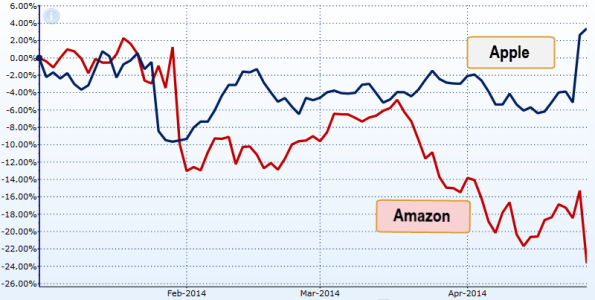U.S. stocks have displayed substantial volatility thus far in 2014, but gained little ground overall following 2013′s spectacular returns. When stocks churn up and down but fail to establish a definite direction, analysts will sometimes say prices are “consolidating,†or “stuck in a trading range.â€
But that does not mean that the prices of individual stocks all follow the same directionless pattern. The chart below shows the percentage change in the prices of two popular technology stocks, Apple and Amazon, from early January to late April 2014.

While both stocks started the year with losses, declining by 10% (Apple) and 13% (Amazon) by late January, Apple went on to earn a positive return (+4%), while Amazon’s stock has continued to slide, accumulating losses of almost 24% over the same period. The two companies’ very different reactions to their recent earnings announcements in late April can be seen in the chart — Apple’s stock gained almost 8% in one day, while Amazon’s declined by almost the same amount. What caused these two tech giants to have such different returns thus far in 2014?
The answer has to do with the ability to grow profits and earn a sufficient return on the capital invested in each company, usually referred to as a company’s “fundamentals.†The next graph compares each stock’s gross profit margin, which measures the percentage of sales revenue left over after covering basic costs. The companies look competitive, with Amazon gradually expanding its gross margin.

But when we progress a little further down the income statement and compare each stock’s operating profit margin, which takes a more complete range of expenses into account, a different picture emerges:

Apple posts a consistently positive operating margin that fluctuates between 25-35%, while Amazon’s starts out low (below 5%) and deteriorates further, all the way down to 1% for fiscal year 2013. Worse still, Amazon has pre-warned the market that it is likely to lose money in the 2nd and 3rd quarters of 2014, with the possibility of even further deterioration in its operating margin. The market clearly disapproves of this trend, and has reacted by punishing Amazon’s stock price.

